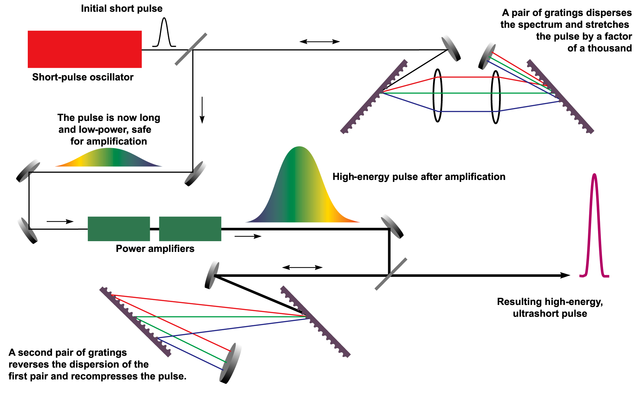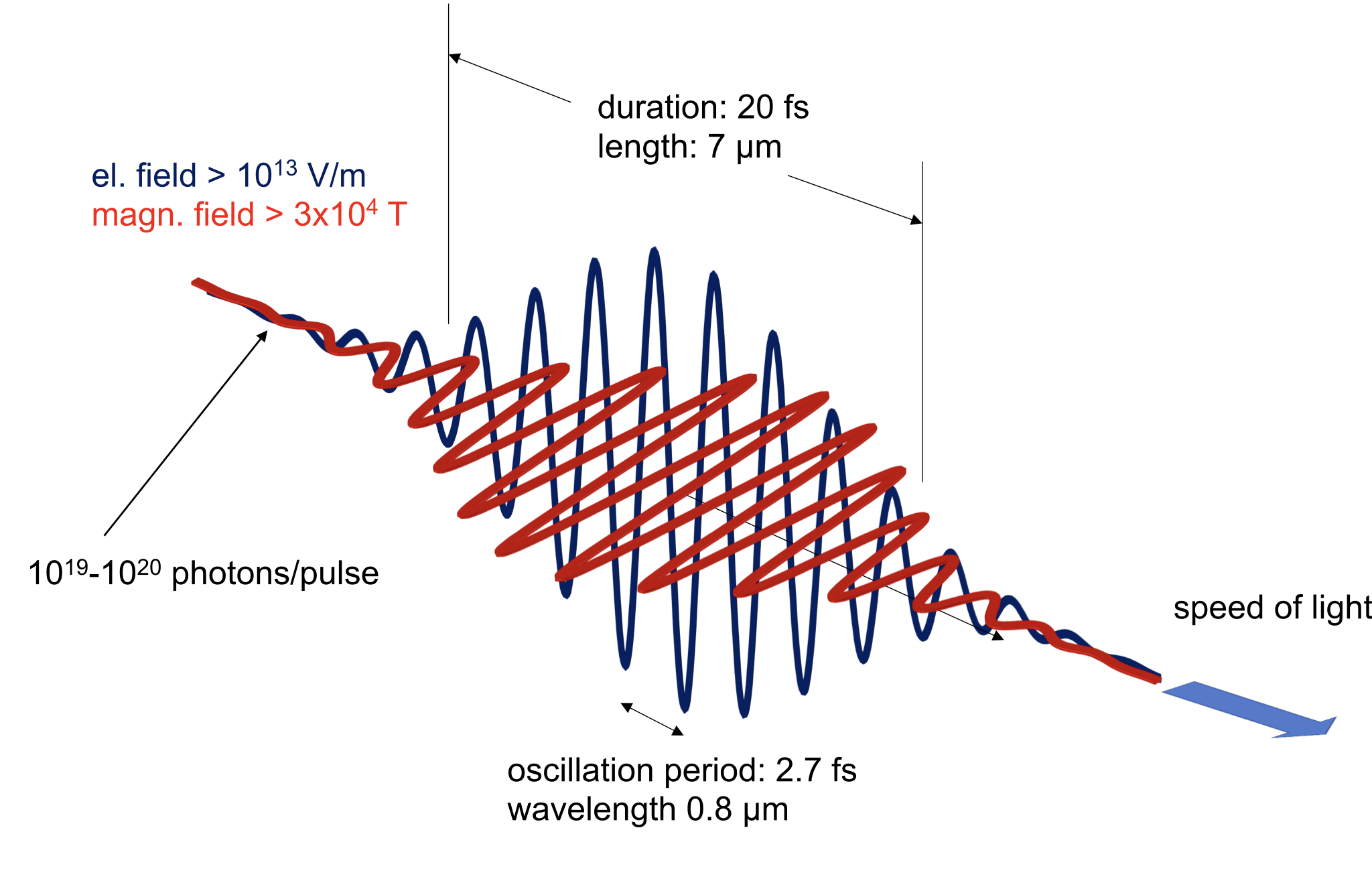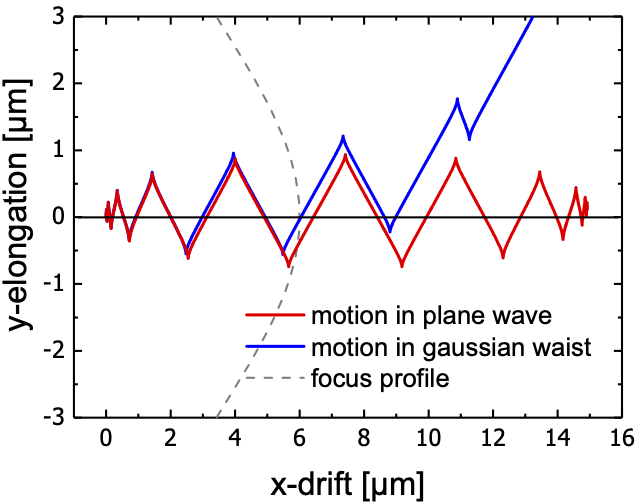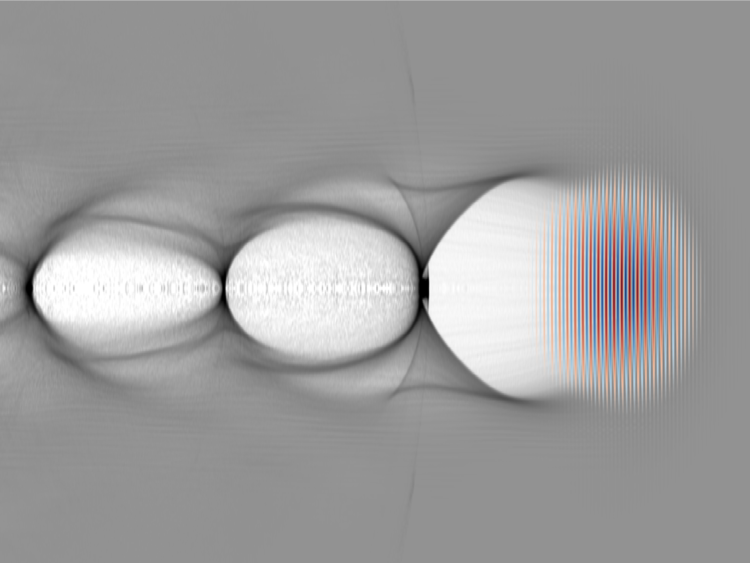What is petawatt physics?
Laser sources
The world's most powerful laser systems currently provide peak powers of a petawatt (1015W = 1.000.000.000.000.000 W) or even more. Reaching these extreme powers is possible via Chirped Pulse Amplification (Nobel Prize in Physics 2018, Donna Strickland & Gerard Mourou). Here a short, low energy pulse is stretched in time and then amplified in several so-called power amplifiers.

Illustration of the CPA process (source: wikipedia).
Ultrashort optical pulses
The light pulses provided by such CPA lasers are approximately 20-30 fs long, corresponding to 7-10 optical cycles of the light field at their central wavelength of 800 nm. Once they are focused to a size between a few µm and a few 10’s of µm, their electromagnetic fields surpass other macroscopic fields reached in the laboratory by orders of magnitude, reaching values of 1013-3x1014 V/m for the electric and 3x104-106 Tesla for the magnetic field. The electric field therefore is 300 million times stronger than the magnetic field, which is the same number as the speed of light (300 million meters/second) As light is an electromagnetic wave, these fields are oriented transversely to their propagation direction. Matter is instantly ionized by these fields, leaving only charged particles (ions and electrons) for the interaction.

Cartoon picture of an ultrashort, ultraintense light pulse
Motion of single electrons in intense light pulses: ponderomotive repulsion
As the lightest constituents of the plasma, electrons can be accelerated by the light field much more easily than the ions, which remain virtually inert. Transverse light fields acting on electrons cause a transverse oscillatory motion, i.e. the electrons start quivering in a direction perpendicular to the pulse propagation in the plane of the electric field. Since the force of the much weaker magnetic field depends not only on the field itself, but on its product with the electron velocity, the magnetic field becomes as strong as the electric field once the electrons reach the speed of light during their quivering motion. This happens at intensities above 1018 W/cm2, and gives rise not only to a transverse motion, but also to a forward drift. In a focused pulse, another effect becomes important: Since the light intensity declines away from the propagation axis, an electron that has quivered away from the axis feels a weaker restoring force once the field direction reverses during the next period, leading to a gradual drift away from the optical axis. Together, these effects give rise to an electron trajectory which expels it from regions of high intensity with a velocity close to the speed of light.
In conclusion, intense light acts as a snowplough for electrons, pushing them out of the way, and leaving the plasma ions behind, thereby generating large, quasi-static charge-separation fields. As they are in part oriented parallel to the propagation direction, this process effectively transforms the oscillating transverse laser fields into longitudinal acceleration fields.

Electron motion in an intense plane wave (red) and a laser focus (blue), the latter leading to expulsion from the focus.
Particle acceleration of electrons and ions
Depending on the plasma density, the intense light pulses can either penetrate the plasma or get reflected at the plasma surface. In the first case, they travel through the plasma with nearly the speed of light, exiting a charge-separation wave in their wake. Also termed wakefield, this plasma wave and its associated charge separation field trails the laser pulse with a fixed phase relation to the laser pulse, just as a boat leaves a water wave in its wake. Electrons with enough forward velocity can surf this wake and gain energy, which due to the wake’s ultrastrong fields happens much more rapidly than in conventional particle accelerators. Able to reach GeV energies in a mere centimeter in ultrashort and -dense bunches, such accelerators are a strong technology contender for future compact electron accelerators.

Simulation snapshot of the plasma wake generated behind an intense laser pulse (travelling from left to right)
Due to their larger mass, ions take much longer to reach the speed of light than electrons, and even the most powerful lasers are not able to accelerate ions to velocities close to the speed of light within an oscillation period of the light. Therefore, a different approach is needed to realize a laser-driven ion accelerator. A slow enough co-moving acceleration field would require an impractical plasma density, such that ion acceleration mainly draws on creating a static longitudinal field as strong as possible for as long as possible a time. The most popular approach is reflecting the strong laser pulses off a thin, dense plasma slab, thereby setting up a static charge separation layer that exists for as long as the laser drives it. While reaching fields of the same magnitude as the laser fields itself, this process can accelerate ions to 10-100 MeV/nucleon within 25 fs or over a distance of a few microns.
Applications of laser-driven secondary particles
Particle accelerators are among the most versatile tools for all aspects of modern science: From unravelling the mysteries of the matter that constitutes our universe, the production of highly resolving X-ray sources for medicine and industry, ion beams for cancer therapy, production of exotic nuclei and material modification all the way to probing the properties of vacuum itself, particle accelerators play a key role. It is expected that the unique properties of laser-driven accelerators, such as their ultrashort duration and extremely high bunch densities will provide new aspects to these established fields and may even create new areas of science. At PULSE, we are studying the creation of ultrashort pulses of tuneable X-rays for medical imaging and cargo scanning, the use of laser-driven electron bunches to drive hybrid accelerators with even higher bunch density, and the properties of the quantum vacuum at the highest fields. Moreover, we study the acceleration of ultrashort and dense ion bunches for developing future hadron therapy treatment strategies, combined ion-X-ray multi-modal imaging for treatment surveillance and as sources for studying stellar nucleosynthesis via neutron-rich fusion reactions in the laboratory for the first time.
Laser and facility development
The scientific output of a facility like Pulse@CALA strongly depends on the availability of top-notch laser beam parameters for our experiments. This mandates a constant effort for keeping the lasers at a competitive level, via a combination of optimization, upgrade and new developments. Therefore, we constantly strive to characterize ATLAS-3000 using the latest commercial tools, but also develop new approaches addressing the specific challenges characterizing higher-order aberrations that are particularly affecting Petawatt pulses with their large optics. Moreover, as the field of high-power lasers evolves towards ever higher repetition rates and average power, we develop new laser architectures for future laser-driven X-ray sources in particular.

